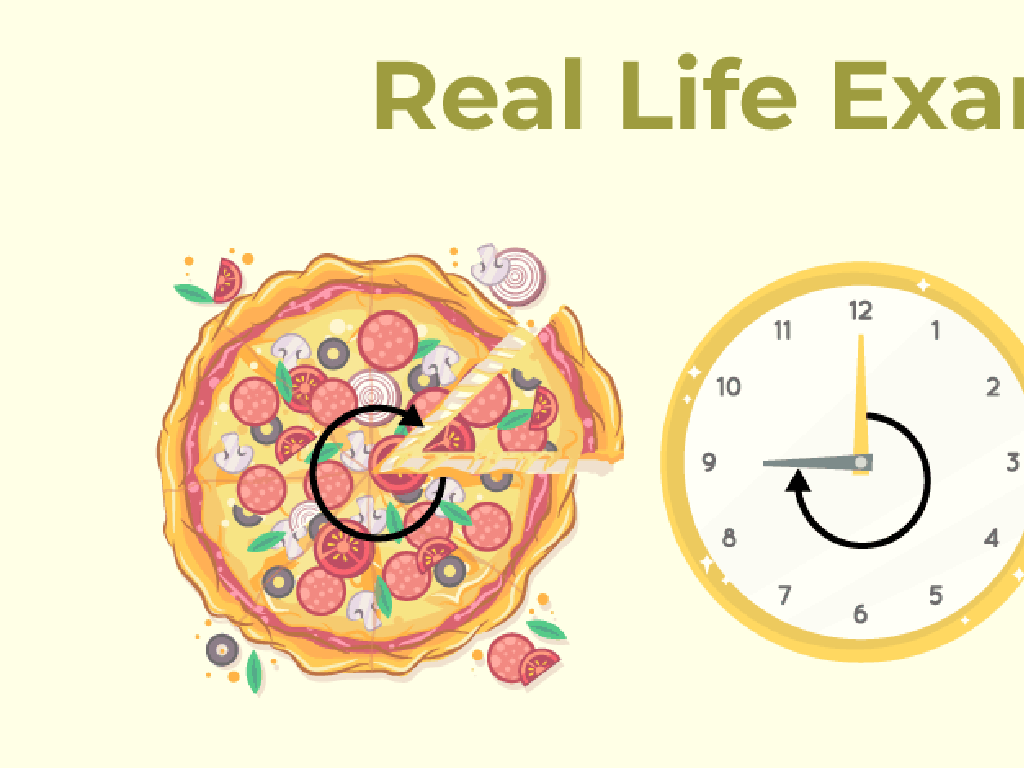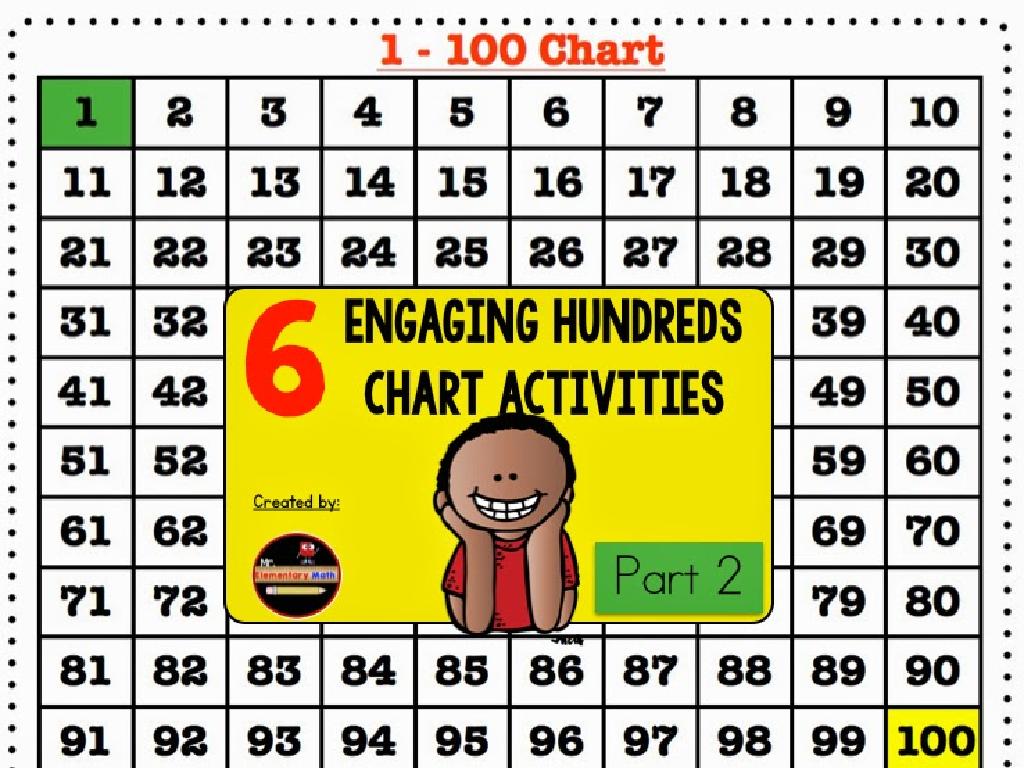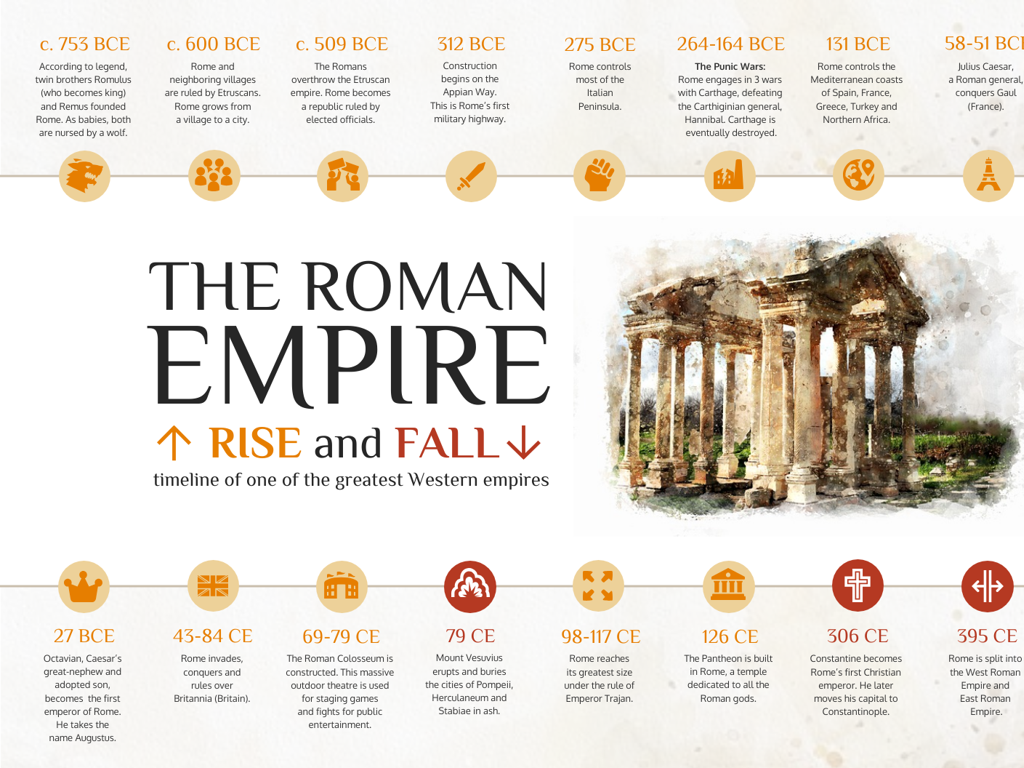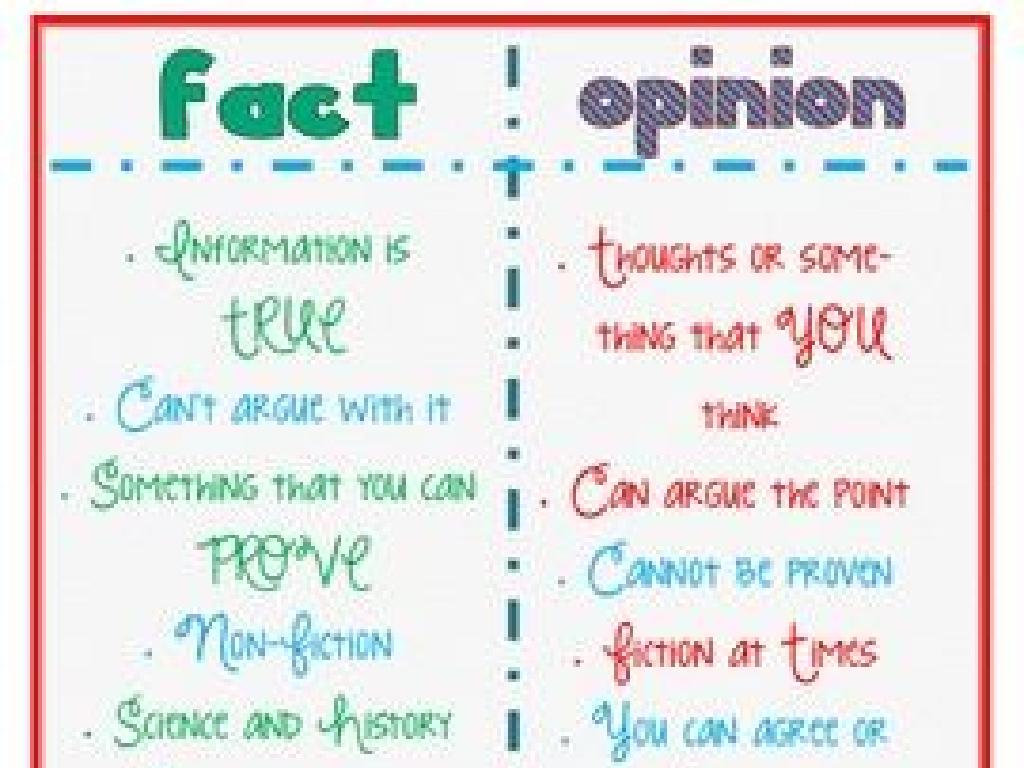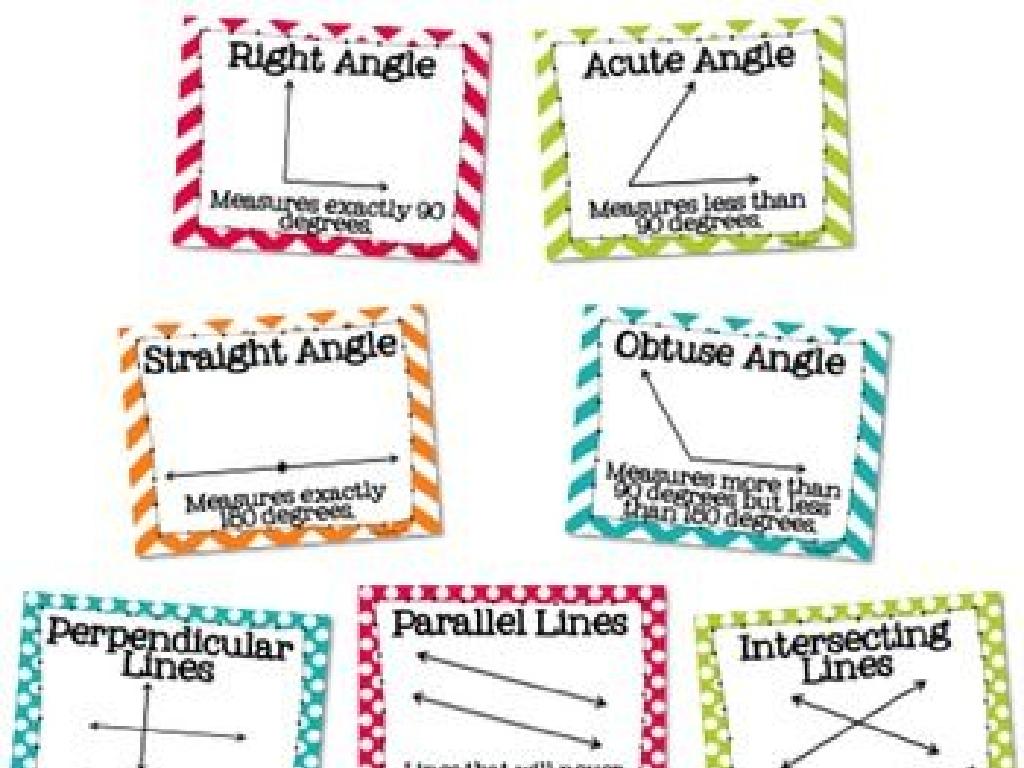Is The Sentence Declarative, Interrogative, Imperative, Or Exclamatory?
Subject: Language arts
Grade: Fifth grade
Topic: Sentences, Fragments, And Run-Ons
Please LOG IN to download the presentation. Access is available to registered users only.
View More Content
Identifying Types of Sentences
– Learn sentence types
– Declarative states a fact, Imperative gives a command, Interrogative asks a question, Exclamatory shows strong emotion.
– Discover punctuation’s role
– Punctuation marks like periods, question marks, and exclamation points help identify the type of sentence.
– Explore 4 sentence types
– Declarative: ‘The sky is blue.’, Interrogative: ‘What color is the sky?’, Imperative: ‘Describe the sky.’, Exclamatory: ‘What a beautiful blue sky!’
– Practice identifying them
|
This slide introduces the concept of different sentence types to the students. It’s crucial to explain that the purpose of a sentence can be identified by both its structure and punctuation. Declarative sentences make statements, interrogative sentences ask questions, imperative sentences give commands or make requests, and exclamatory sentences express strong emotion. Use examples to illustrate each type and encourage students to come up with their own examples. In the next class, practice activities can include identifying sentence types in passages and writing original sentences of each type.
Exploring Sentence Types
– Definition of a sentence
– A sentence is a complete idea expressed through words.
– Sentence structure essentials
– Every sentence needs a subject and a verb.
– Varieties of sentences
– Sentences can be declarative, interrogative, imperative, or exclamatory.
– Punctuation’s role
– Correct punctuation helps convey the right meaning.
|
This slide introduces students to the basic concept of what constitutes a sentence. Emphasize that a sentence is not just a random collection of words, but a complete thought that makes sense on its own. Highlight the importance of having both a subject and a verb to form a proper sentence structure. Discuss the four types of sentences: declarative (making a statement), interrogative (asking a question), imperative (giving a command), and exclamatory (expressing strong emotion), and how punctuation marks like periods, question marks, and exclamation points help to distinguish between them. Use examples to illustrate each type. Encourage students to create their own sentences in each category as practice.
Types of Sentences: Declarative
– Declarative sentences state facts
– They tell us something specific and end with a full stop
– They always end with a period
– This punctuation shows the sentence is a statement, not a question or exclamation
– Example: ‘The cat is sleeping.’
– It’s a simple sentence that gives information about the cat
|
This slide introduces declarative sentences, which are the most common type of sentence used to convey information or ideas. They are straightforward and end with a period. Use the example provided to show students how a declarative sentence functions. Ask students to come up with their own examples of declarative sentences and write them down. This will help them understand the concept and recognize declarative sentences in their reading and writing. Encourage them to notice the punctuation as a key indicator of the sentence type.
Exploring Interrogative Sentences
– Interrogative sentences ask questions
– These sentences are looking for an answer.
– They always end with a question mark
– Remember, the question mark is key!
– Example: ‘Are you going to the park?’
– This sentence asks about someone’s plans.
|
This slide introduces the concept of interrogative sentences to the students. Emphasize that interrogative sentences are used to ask questions and they always end with a question mark. Provide the example ‘Are you going to the park?’ and ask the students what the sentence is asking about. This will help them understand how to identify interrogative sentences. Encourage the students to come up with their own examples of questions they might ask their friends or family. Discuss how the tone of our voice changes when we ask a question, often rising at the end of the sentence. This will prepare them to not only recognize interrogative sentences in writing but also in speech.
Exploring Imperative Sentences
– Imperative sentences give commands
– They tell us to do something, like ‘Sit down.’
– They may end with a period or exclamation mark
– Use a period for calm commands, exclamation mark for urgency!
– Example: ‘Please take out your books.’
– This is a polite request to start our reading activity.
|
This slide introduces imperative sentences, which are used to issue commands or make requests. It’s important to highlight that while they often end with a period, they can also end with an exclamation mark to express urgency or strong emotion. Provide the example ‘Please take out your books.’ to show a polite request. Encourage students to think of other commands they hear daily at home or in school. Discuss how the tone of a command can change based on punctuation. Have students practice writing their own imperative sentences, both with periods and exclamation marks, to understand the difference in tone.
Exclamatory Sentences
– Express strong emotions
– Show excitement, surprise, or strong feeling
– End with an exclamation mark
– The exclamation mark (!) is key
– Example: ‘What a beautiful day!’
– ‘What a beautiful day!’ shows happiness about the weather
|
Exclamatory sentences are used to convey strong emotions such as excitement, surprise, happiness, or anger. They are easily identified by their ending punctuation, the exclamation mark (!). This slide provides an understanding of how exclamatory sentences are formed and their purpose in written language. The example given should help students recognize exclamatory sentences in their reading and use them in their writing. Encourage students to come up with their own examples of exclamatory sentences and to share them with the class to reinforce their understanding.
Let’s Practice Sentence Types!
– Identify sentence types we read
– Discuss reasons for sentence categories
– Why is a question interrogative? Why does an order sound imperative?
– Write your own sentence examples
– Create a declarative, interrogative, imperative, and exclamatory sentence.
– Share and review with the class
– Get feedback on your sentences and understand them better.
|
This slide is designed for an interactive class activity. Students will practice identifying different sentence types: declarative (statements), interrogative (questions), imperative (commands), and exclamatory (strong feelings). After reviewing examples together, students will discuss why each sentence fits its category, focusing on punctuation and sentence structure. Then, they will write their own examples of each sentence type to solidify their understanding. Encourage creativity and sharing among students to foster a collaborative learning environment. As a teacher, provide guidance and clarification as needed, and ensure that each student participates and receives constructive feedback.
Sentence Sorting Activity
– Work together in small groups
– Sort sentences into categories
– Declarative, interrogative, imperative, exclamatory
– Use sentence strips provided
– Place strips under correct sentence type
– Use the board to organize your sentences
|
This activity is designed to help students understand the four types of sentences by sorting them into categories: declarative, interrogative, imperative, and exclamatory. Each group will be given a set of sentence strips and will collaborate to determine the type of each sentence. Once sorted, they will place the strips on the board under the correct heading. This hands-on approach reinforces the lesson and encourages teamwork. As a teacher, walk around to assist groups as needed, ask guiding questions, and ensure that each student is participating. Possible variations of the activity could include having students write their own sentences to sort, or challenging them to convert sentences from one type to another.
Class Activity: Crafting Stories with Sentence Types
– Write a story with 4 sentence types
– Include declarative, interrogative, imperative, exclamatory
– Share your story with classmates
– Discuss sentence variety benefits
– How do different sentences change your story’s feel?
– Reflect on the activity
– Think about what you learned and how you felt
|
This activity is designed to help students understand the use of different sentence types in writing. By creating a story that includes declarative, interrogative, imperative, and exclamatory sentences, students will learn how each type contributes to the tone and flow of their writing. After writing, students will share their stories in small groups or with the entire class to discuss how the variety of sentences affects their storytelling. Encourage them to notice how questions can create suspense, commands can show urgency, and exclamations can convey strong emotion. This reflection will help them appreciate the power of sentence variety in writing. Provide guidance and examples if needed, and ensure a supportive environment for sharing.
Review and Reflection: Sentence Types
– Recap the 4 sentence types
– Declarative states facts, interrogative asks, imperative commands, exclamatory shows strong emotion.
– Improving writing with sentence types
– Using varied sentence types makes writing more engaging and clear.
– Homework: Craft a mixed-sentence paragraph
– Write a paragraph using declarative, interrogative, imperative, and exclamatory sentences.
|
Today’s lesson focused on the four types of sentences: declarative, interrogative, imperative, and exclamatory. Understanding these helps students express different kinds of information and emotions effectively. For homework, students will apply this knowledge by writing a paragraph that includes all four sentence types, which will reinforce their learning and enhance their writing skills. In the next class, we can review some of the paragraphs to discuss how the different sentences contribute to the overall structure and tone of their writing.

